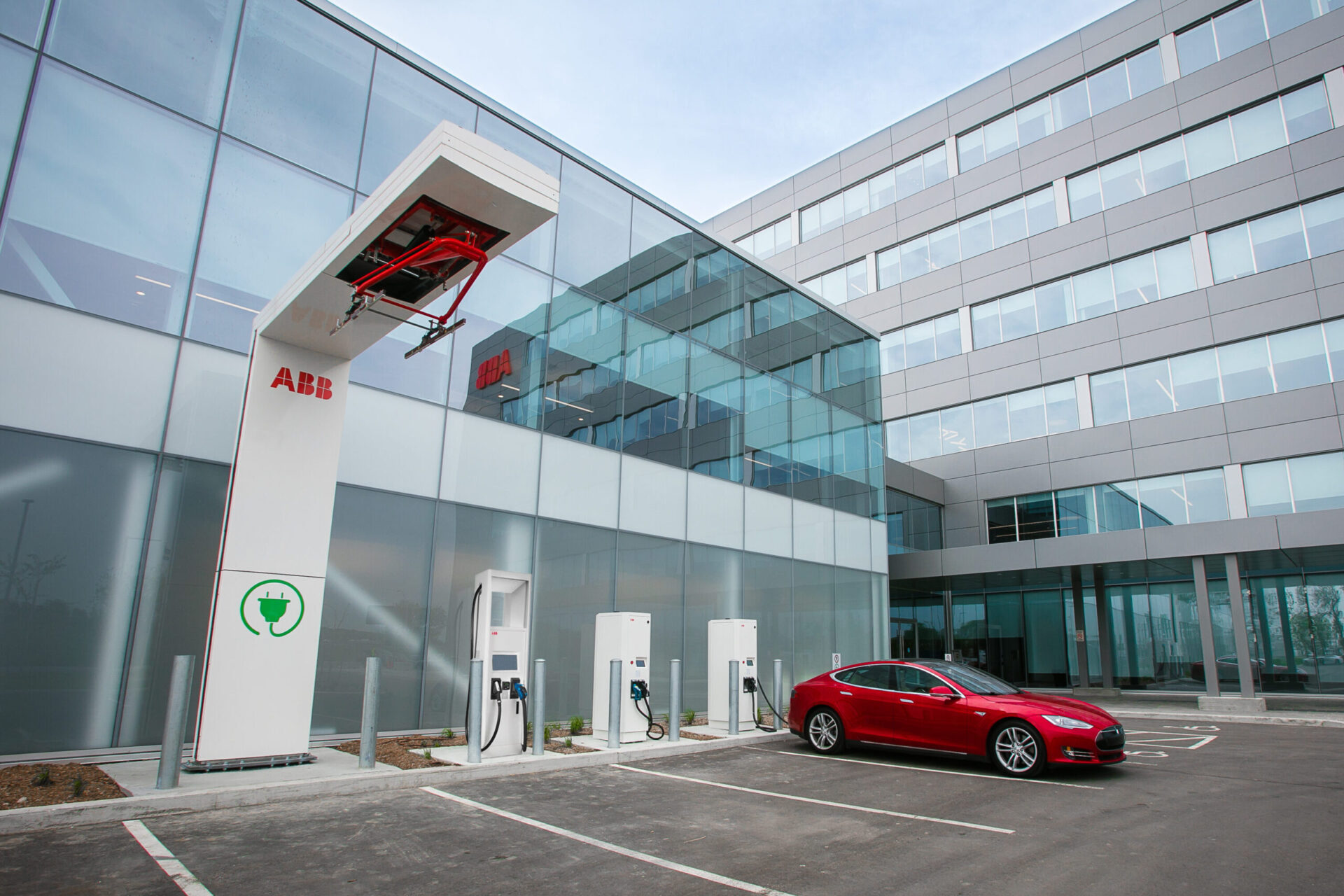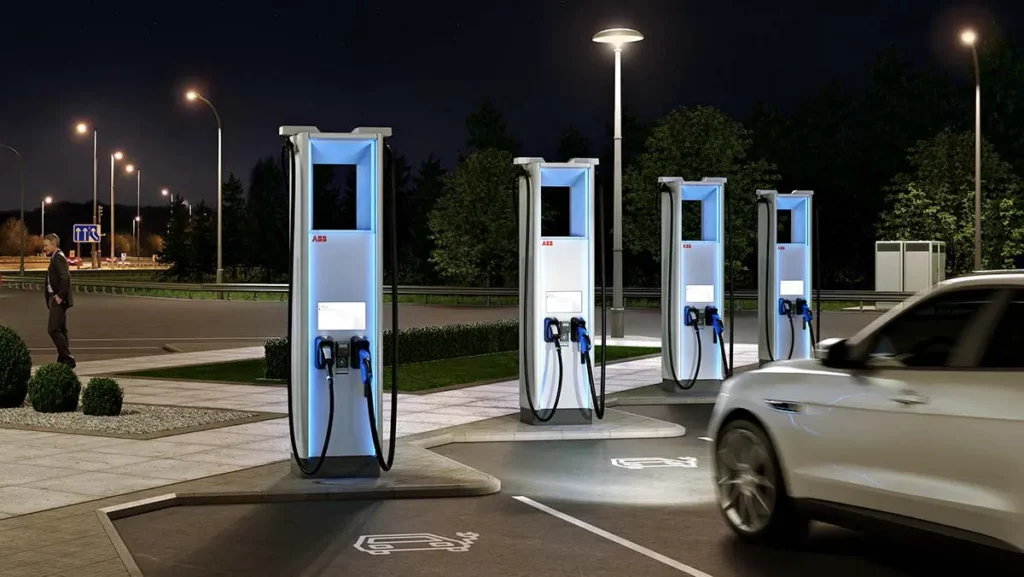The most important difference between combustion vehicles and electric vehicles is ditching the gas-and-go mentality. Most EV charging happens overnight, either at drivers’ homes or in a depot. With the right approach, you’ll save money and save time, too. Your drivers may never again have to stop during the workday to fuel up.
To gain this benefit, you’ll need to invest up-front in charging infrastructure, which we’ll walk you through in this lesson. First, let’s go over the basics. Welcome to Charging 101.
“The minute the customer thinks about acquiring vehicles, they should also be thinking about charging that vehicle.”
— Kevy Stephen, EV Charging Solutions Launch Manager at Ford Pro
EV charging hardware

Technically, the charger is part of the car. An on-board charger converts AC to DC to recharge the battery pack or regulates the flow of DC current to the level at which the battery pack is able to charge.
Electric vehicle supply equipment
What most of us call a charging station for convenience is more accurately called “EVSE” or Electric Vehicle Supply Equipment. For AC charging, the EVSE is primarily there to provide a safe way to transmit more power to the vehicle. It uses a simple protocol to communicate with the vehicle and determine how much power the EV can safely draw.
“At the beginning of the charge session, the vehicle transmits its parameters to the charger — current state of charge, max input power, max input current, max voltage, and so on. The charger then acknowledges this information and respects the demands of the vehicle.”
— Matthew Bartolone, ABB E-Mobility
Electrical service supply
Though charging station outputs are listed in kilowatts, the output delivered is determined by the voltage (V) and amperage (A) of the electrical connection supplying the station. Voltage relates to the pressure of the electrical flow, while amperage relates to the volume of that flow. Small changes in amperage can have a significant impact on power output, which is why you will see amperage and voltage ratings mentioned when discussing various configurations of Level 2 and DC Fast chargers.
EV charging levels
One of the terms you’ll hear most often about EV charging is levels. An EV can charge at different power levels, which will affect how quickly the charging station can recharge it.
Level 1 charging
This is the term for charging with 120 volts of AC power — in other words, a good old household plug. By plugging in with the mobile charger that comes with a Ford Mustang Mach-E, Ford estimates the battery will recover 5 kilometres of charge per hour (we’re using the extended-range battery and rear-wheel drive for our example). So, on an eight-hour overnight charge, the Mach-E will recover 40 km of range.1 This might get you to the first stop on your shift or back to the depot, but most fleet operators will need more power.
Level 2 charging
Level 2 means charging with 240 volts of AC power. This could happen either on the type of outlet used by home appliances (like a stove or clothes dryer) or with a Level 2 charging station installed, which can provide even more kW. By using a 10.5 kW, 48-amp hardwired charging station (the maximum a Ford Mach-E can handle in AC), the rate of charge will be 45 kilometres per hour or 360 kilometres of range in eight hours. This solution makes sense for most drivers.
DC Fast Charging
Often referred to as Level 3, DC Fast Charging is most often associated with the high-powered charging points you’ll find at service stations or other roadside locations, which are in the 50 kW to 350 kW range.
Note that charging is not a straight line: the first 50 per cent will charge up quickly, while the last 20 per cent is typically much slower, in order to protect the battery. This is why most automakers indicate a 10 per cent to 80 per cent charge time in their vehicle descriptions.
This type of charging is faster, but it’s still not as fast as filling up an ICE car. DC Fast charging slows down a lot once the battery hits 80 per cent, which helps protect the battery from damage due to overcharging. The Ford Mach-E mentioned above can recover 94 kilometres of range in 10 minutes at a 150 kW public charger — or, put differently, it goes from 10 per cent to 80 per cent charge in 45 minutes. Not all public charging stations charge at this rate – the more common 50 kW stations will give a slower charge. Note that vehicle manufacturers recommend minimizing the use of DC Fast Charging as it can affect battery performance and lifespan.
Smart charging refers to software that connects the EV’s on-board computer to the charging station’s own computer to enable functionality such as remote charging (when an EV is plugged in) and scheduled charging. If you install a charging station with smart-charging software you’ll have access to additional functionality, such as sharing the load between multiple vehicles — relevant when Level 2 chargers are installed in a depot.
Read more about smart charging in the sections on Depot charging and Telematics energy management.
EV charging compatibility

Not all EVs take the same types of plugs to connect to the charging hardware. As we noted in Lesson 1: Understanding Electric Vehicles, some legacy products may come with separate J1772 and CHAdeMO ports, while the majority of EVs produced through 2023 come with a J1772-CCS combination plug that can accept either Level 2 or 3 charging.
Teslas have a different plug style entirely, the North American Charging Standard (NACS), which can now work with an adapter at non-Tesla stations. The NACS system has been adopted by a number of automakers including Ford, General Motors, Nissan, Polestar, Rivian and Volvo who will switch to this connector on their vehicles starting in 2024 or 2025.
Make sure the vehicles you acquire share a common connector or, if you can’t, be sure to install enough chargers of the specific connector types you’ll need.
Also keep in mind that vehicles have their charging ports in different locations. Even two cars from the same automaker may have ports in different places: a Hyundai Kona electric’s port is under the grille, while a Hyundai IONIQ 5’s port is on the right rear corner, similar to a gas tank. Be sure to plan spaces that work for cars parked in a variety of directions.
Click Save progress to continue. The rest of this lesson will show you how to select and set up your charging infrastructure.
Reproduction of any or all of this material is strictly prohibited without permission. Please contact [email protected] for inquiries. Copyright © 2024 – Electric Autonomy Canada – ArcAscent Inc. – All Rights Reserved
Want to learn more? Sign up or log in so you can track your progress, earn a course certificate and receive exclusive invitations to our live learning sessions.